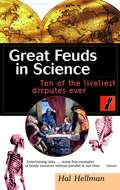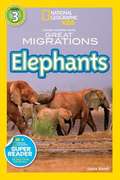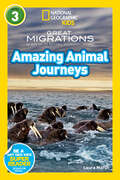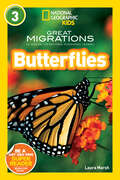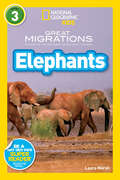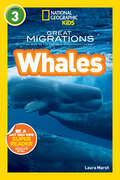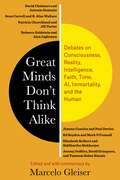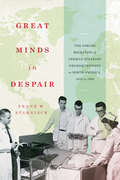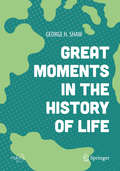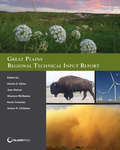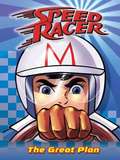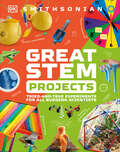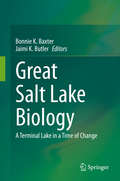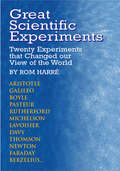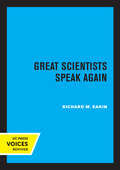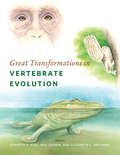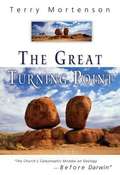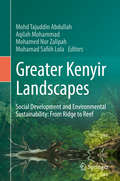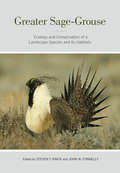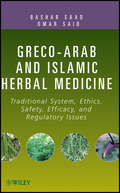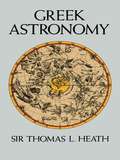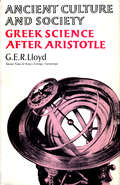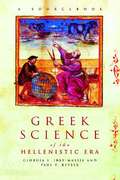- Table View
- List View
Great Feuds In Science: Ten Of The Liveliest Disputes Ever
by Hal HellmanThe dramatic stories of ten historic feuds: How they altered the course of discovery-and shaped the modern world Hall Hellman tells the lively stories of ten of the most outrageous and intriguing disputes from the seventeenth to the twentieth centuries. Bringing the cataclysmic clash of ideas and personalities to colorful life, Hellman explores both the science and the spirit of the times. Along the way, he reveals that scientific feuds are fueled not only by the purest of intellectual disagreements, but also by intransigence, ambition, jealousy, politics, faith, and the irresistible human urge to be right.
Great Lives: Masters of Science
by Neeti JaychanderLife stories of eminent scientists who invented different things that makes the world move forward and advance in development.
Great Migrations - Elephants
by Laura MarshThis exciting reader follows the story of the longest and the most demanding elephant migration on the planet. Living at the furthest corners of the hot and dry Sahara Desert, the very margins of where elephants can survive, hundreds of these great creatures make a dangerous but necessary journey as their main source of food and water dries up and they must go in search of more. Battling 120-degree heat, sandstorms, and fierce thunderstorms, these amazing animals travel 35 miles a day in a race against time in search of the bare essentials of life. National Geographic supports K-12 educators with ELA Common Core Resources. Visit www. natgeoed. org/commoncore for more information.
Great Migrations Amazing Animal Journeys (Readers)
by Laura MarshEvery year like clockwork, animals both big and small are driven by a natural instinct to move, in order to survive. On both land and sea, they fight the odds and the forces of nature to breed, feed, or lead and carry on for future generations. This reader is an introduction to the treacherous trek of the zebra, walrus, and Christmas Island red crab to overcome obstacles that include hungry cheetahs, stinging yellow crazy ants, and even their fellow species to make the often impossible journey of their lives.National Geographic supports K-12 educators with ELA Common Core Resources.Visit www.natgeoed.org/commoncore for more information.
Great Migrations Butterflies (Readers)
by Laura MarshThe monarch butterfly, one of the most seemingly delicate of all of nature&’s animals, proves to be one of the toughest in this reader. Making the yearly trip from the Northern United States and Canada to the Oyamel forest of Mexico is no easy task, and it takes five generations of butterflies in order to do so. Battling cold temperatures and the threat of starvation, these beautiful insects complete an almost 3,000 mile journey over the course of two months, only to have to turn and around and head back home.National Geographic supports K-12 educators with ELA Common Core Resources.Visit www.natgeoed.org/commoncore for more information.
Great Migrations Elephants (Readers)
by Laura MarshThis exciting reader follows the story of the longest and the most demanding elephant migration on the planet. Living at the furthest corners of the hot and dry Sahara Desert, the very margins of where elephants can survive, hundreds of these great creatures make a dangerous but necessary journey as their main source of food and water dries up and they must go in search of more. Battling 120-degree heat, sandstorms, and fierce thunderstorms, these amazing animals travel 35 miles a day in a race against time in search of the bare essentials of life.National Geographic supports K-12 educators with ELA Common Core Resources.Visit www.natgeoed.org/commoncore for more information.
Great Migrations Whales (Readers)
by Laura MarshOver the course of their 70-year lifespan, sperm whales will easily travel the circumference of the Earth in search of food and the need to breed and find a mate. Males will travel as far north as the Bering Sea and as far south as Antarctica in order to find enough food to sustain their ways of live—up to 700 squid a day! Along the way, these massive beasts battle 30-feet-long giant squids, and each other, to sustain their ways of life.National Geographic supports K-12 educators with ELA Common Core Resources.Visit www.natgeoed.org/commoncore for more information.
Great Minds Don’t Think Alike: Debates on Consciousness, Reality, Intelligence, Faith, Time, AI, Immortality, and the Human
by Marcelo GleiserDoes technology change who we are, and if so, in what ways? Can humanity transcend physical bodies and spaces? Will AI and genetic engineering help us reach new heights or will they unleash dystopias? How do we face mortality, our own and that of our warming planet? Questions like these—which are only growing more urgent—can be answered only by drawing on different kinds of knowledge and ways of knowing. They challenge us to bridge the divide between the sciences and the humanities and bring together perspectives that are too often kept apart.Great Minds Don’t Think Alike presents conversations among leading scientists, philosophers, historians, and public intellectuals that exemplify openness to diverse viewpoints and the productive exchange of ideas. Pulitzer and Templeton Prize winners, MacArthur “genius” grant awardees, and other acclaimed writers and thinkers debate the big questions: who we are, the nature of reality, science and religion, consciousness and materialism, and the mysteries of time. In so doing, they also inquire into how uniting experts from different areas of study to consider these topics might help us address the existential risks we face today. Convened and moderated by the physicist and author Marcelo Gleiser, these public dialogues model constructive engagement between the sciences and the humanities—and show why intellectual cooperation is necessary to shape our collective future.Contributors include David Chalmers and Antonio Damasio; Sean Carroll and B. Alan Wallace; Patricia Churchland and Jill Tarter; Rebecca Goldstein and Alan Lightman; Jimena Canales and Paul Davies; Ed Boyden and Mark O’Connell; Elizabeth Kolbert and Siddhartha Mukherjee; Jeremy DeSilva, David Grinspoon, and Tasneem Zehra Husain.
Great Minds in Despair: The Forced Migration of German-Speaking Neuroscientists to North America, 1933 to 1989 (McGill-Queen's/AMS Healthcare Studies in the History of Medicine, Health, and Society)
by Frank W. StahnischThe twentieth century witnessed two devastating world wars that led to the exodus of millions of people. Counted among them were hundreds of neuroscientists and biological psychiatrists from Nazi Germany and its surrounding countries who were forced to emigrate in the 1930s and 1940s. Many of them settled in North America, where they profoundly influenced the development of the biomedical sciences.Focusing on the years between 1933 and 1989, Great Minds in Despair examines the long-term effects of this forced migration on scientific and medical cultures in North America and on the researchers themselves. Frank Stahnisch traces the lives and careers of approximately four hundred German-speaking doctors, scientists, and researchers over two generations. Placed in unfamiliar research settings in Canada and the United States, they helped to build the fields of neuroscience, psychiatry, clinical psychology, and the cognitive sciences, even as they rebuilt their own lives amid myriad challenges including cultural adaption and the complications of relicensing. Stahnisch explores how generational factors, gender, international networking, refugee organizations, and national funding agencies shaped their experiences and affected postwar remigration.Great Minds in Despair provides an important revision to the brain gain thesis in migration studies by turning attention to the working conditions and social acculturation of an influential academic refugee group in North America.
Great Moments in the History of Life (Springer Praxis Books)
by George H. ShawA non-technical (but serious) treatment of those parts of Earth history leading up to human history, as well as some pre-historical aspects of humanity. Many “events” in Earth’s history necessarily preceded the emergence of human beings (and intelligence). Geology has provided us with a great deal of information about these various steps on the way to intelligent life, and how and why they were important. Some of these events were on a cosmic scale (no universe – no life!), some were planetological/astronomical (no Earth – no life), some were essentially chemical (how did life emerge in the primordial ocean and why do we have oxygen in the atmosphere?), and some were details of evolutionary history (how did life colonize the land and how did mammals develop?). In this book an enthusiastic professor of geosciences presents a broad introduction from the Big Bang to the present and into the future, lucidly explaining aspects from various disciplines to interested, non-specialist readers.
Great Plains Regional Technical Input Report
by Dennis Ojima Jean Steiner Karen Cozzetto Shannon Mcneeley Amber ChildressPrepared for the 2013 National Climate Assessment and a landmark study in terms of its breadth and depth of coverage, Great Plains Regional Technical Input Report is the result of a collaboration among numerous local, state, federal, and nongovernmental agencies to develop a comprehensive, state of the art look at the effects of climate change on the eight states that encompass the Great Plains region. The Great Plains states are already experiencing the impacts of a changing climate, and will likely continue to experience warming temperatures, more extreme precipitation events, reduced snow and ice cover, and rising relative sea levels. The book presents a review of the historic, current, and projected future climate of the region; describes interactions with important sectors of the Northeast and examines cross-sectoral issues, namely climate change mitigation, adaptation, and education and outreach. Rich in science and case studies, it examines the latest climate change impacts, scenarios, vulnerabilities, and adaptive capacity and offers decision makers and stakeholders a substantial basis from which to make informed choices that will affect the well-being of the region's inhabitants in the decades to come.
Great Plan, The #1
by Chase WheelerSpeed Racer enters the high-octane Sword Mountain Race, but not everyone is in it to win. Some of the competitors are more interested in stealing the new plans for Speed's car, the Mach 5, than crossing the finish line. Can Speed save the top-secret plans and still win the race?
Great STEM Projects
by DKExplore Science, Technology, Engineering, and Maths with this jam-packed collection of fun-filled experiments you can do at home.Get immersed in exciting STEM activities that will inspire every budding home scientist, technology fan, young engineer, and mathematician! Witness your very own erupting volcano blow sky high. Build a sturdy sandcastle and reveal the incredible technology of construction materials. Design a wind-up car and discover your inner engineer, and test your knowledge of maths by making a marble run. Great STEM Projects features an enormous collection of incredible, tried-and-tested STEM experiments.With over 50 exciting experiments, children aged 9+ will love getting involved in activities like making a wormery, constructing a spaghetti tower, mixing gels to make air fresheners, creating mathematically precise shadow puppets, and freezing icy orbs.This exciting book of experiments for children includes: 50 fun-packed, educational experiments to get kids inspired by the STEM fields: Science, Technology, Engineering, and Maths.A huge variety of activities using easily sourced materials, and ranging from quick and easy to more challenging, to suit different ages, interests and attention spans.Big, beautiful introductory shots for each experiment will engage and excite young readers.Easy-to-understand step-by-step instructions throughout, accompanied by clear, helpful photography.Great STEM Projects is a superb way for teachers and parents to help inspire and develop their kids&’ interest in STEM subjects. Featuring beautiful photography and engaging illustrations accompanied by &“How it works&” and &“Real world&” explanations, young readers can begin to understand the principles of STEM behind each and every step of an experiment.
Great Salt Lake Biology: A Terminal Lake in a Time of Change
by Bonnie K. Baxter Jaimi K. ButlerGreat Salt Lake is an enormous terminal lake in the western United States. It is a highly productive ecosystem, which has global significance for millions of migrating birds who rely on this critical feeding station on their journey through the American west. For the human population in the adjacent metropolitan area, this body of water provides a significant economic resource as industries, such as brine shrimp harvesting and mineral extraction, generate jobs and income for the state of Utah. In addition, the lake provides the local population with ecosystem services, especially the creation of mountain snowpack that generates water supply, and the prevention of dust that may impair air quality. As a result of climate change and water diversions for consumptive uses, terminal lakes are shrinking worldwide, and this edited volume is written in this urgent context. This is the first book ever centered on Great Salt Lake biology. Current and novel data presented here paint a comprehensive picture, building on our past understanding and adding complexity. Together, the authors explore this saline lake from the microbial diversity to the invertebrates and the birds who eat them, along a dynamic salinity gradient with unique geochemistry. Some unusual perspectives are included, including the impact of tar seeps on the lake biology and why Great Salt Lake may help us search for life on Mars. Also, we consider the role of human perceptions and our effect on the biology of the lake. The editors made an effort to involve a diversity of experts on the Great Salt Lake system, but also to include unheard voices such as scientists at state agencies or non-profit advocacy organizations. This book is a timely discussion of a terminal lake that is significant, unique, and threatened.
Great Scientific Experiments: Twenty Experiments that Changed our View of the World
by Rom HarreThese vividly recounted tales of human skill and ingenuity offer fascinating views of the correlation between theories, practical inquiries, ideas, and facts. Re-created strictly on the basis of the original publication in which the results were first announced, the scrupulously accurate retellings of 20 groundbreaking scientific experiments are complemented with rare photos and illustrations.Based on such criteria as fame, historical importance, elegance, and economy of method, the experiments include Aristotle's work on the embryology of the chick, Galileo's discovery of the law of descent, Newton's experiment on the nature of colors, Lavoisier's proof of the oxygen hypothesis, William Beaumont's work on the process of digestion, Faraday's demonstration of the identity of all forms of electricity, J. J. Thompson's discovery of the electron, Michelson and Morely's demonstration of the impossibility of detecting the motion of the earth, and a dozen others.Each experiment is appraised and analyzed in the light of subsequent developments, placing the work within the context of the history of science. In addition to diagrams and photographs of the experimental method and apparatus, brief biographies and portraits of the scientist appear as well.Rom Harré is a Fellow Emeritus of Linacre College, Oxford, and an Adjunct Professor at Georgetown University and American University, Washington, D.C.
Great Scientists Speak Again
by Richard M. EakinThe author writes of this book: "'What lead you to impersonate great biologists?' is a question often asked of me. My answer varies depending upon the interviewer. Sometimes I cite my interest in biographies of distinguished scientists initiated by a reading of Vallery-Radot's The Life of Pasteur as a teenage and furthered by a superb college course on the history of biology. Another answer: my love of the theater, more from the balcony than on the stage as a ham actor. My most frequent reply, however, credits this instructional innovation to the students in my Berkeley course in general biology (Zoology 10), who began to show, in the late sixties, their dissatisfaction with the lecture system. "I gave serious thought to the problem of communicating biological information with greater impact. One morning in the shower I was stuck not only by the spray but also by an idea: dress up and make up as some of the great biologists and present their discoveries and thoughts in their own words. In addition to expounding their scientific work, portray them as persons with hopes and ambitions, frustration over failure, and joy from success. I chose Darwin, Mendel, Harvey, and Pasteur, who would probably be on the most lists of great biologists, and two lesser-known scientists: William Beaumont, pre-Civil War Army surgeon who studied gastic digestion in the stomach of a fur-trapper, Alexis St. Martin; and Hans Spemann, 1935 Nobel Laureate in Physiology and Medicine, who discovered the organizer principle in embryonic development. The results of the innovation, which I call guest lecturers, were gratifying. "Late five of the lectures, in abbreviated form, were recorded on motion picture film (available through the Media Center of the University of California, Berkeley). Then it was suggested that a much wider audience should be reached through publication of the lectures in book form, illustrated with photographs of the 'guest lecturers' in action and with drawings, charts, maps, and reproductions of lantern slides." This title is part of UC Press's Voices Revived program, which commemorates University of California Press's mission to seek out and cultivate the brightest minds and give them voice, reach, and impact. Drawing on a backlist dating to 1893, Voices Revived makes high-quality, peer-reviewed scholarship accessible once again using print-on-demand technology. This title was originally published in 1975.
Great Transformations in Vertebrate Evolution
by Neil Shubin Kenneth P. Dial Elizabeth L. BrainerdHow did flying birds evolve from running dinosaurs, terrestrial trotting tetrapods evolve from swimming fish, and whales return to swim in the sea? These are some of the great transformations in the 500-million-year history of vertebrate life. And with the aid of new techniques and approaches across a range of fields--work spanning multiple levels of biological organization from DNA sequences to organs and the physiology and ecology of whole organisms--we are now beginning to unravel the confounding evolutionary mysteries contained in the structure, genes, and fossil record of every living species. This book gathers a diverse team of renowned scientists to capture the excitement of these new discoveries in a collection that is both accessible to students and an important contribution to the future of its field. Marshaling a range of disciplines--from paleobiology to phylogenetics, developmental biology, ecology, and evolutionary biology--the contributors attack particular transformations in the head and neck, trunk, appendages such as fins and limbs, and the whole body, as well as offer synthetic perspectives. Illustrated throughout, Great Transformations in Vertebrate Evolution not only reveals the true origins of whales with legs, fish with elbows, wrists, and necks, and feathered dinosaurs, but also the relevance to our lives today of these extraordinary narratives of change.
Great Transformations in Vertebrate Evolution
by Neil Shubin Elizabeth L. Brainerd Kenneth P. Dial, Neil Shubin, and Elizabeth L. BrainerdHow did flying birds evolve from running dinosaurs, terrestrial trotting tetrapods evolve from swimming fish, and whales return to swim in the sea? These are some of the great transformations in the 500-million-year history of vertebrate life. And with the aid of new techniques and approaches across a range of fields—work spanning multiple levels of biological organization from DNA sequences to organs and the physiology and ecology of whole organisms—we are now beginning to unravel the confounding evolutionary mysteries contained in the structure, genes, and fossil record of every living species. This book gathers a diverse team of renowned scientists to capture the excitement of these new discoveries in a collection that is both accessible to students and an important contribution to the future of its field. Marshaling a range of disciplines—from paleobiology to phylogenetics, developmental biology, ecology, and evolutionary biology—the contributors attack particular transformations in the head and neck, trunk, appendages such as fins and limbs, and the whole body, as well as offer synthetic perspectives. Illustrated throughout, Great Transformations in Vertebrate Evolution not only reveals the true origins of whales with legs, fish with elbows, wrists, and necks, and feathered dinosaurs, but also the relevance to our lives today of these extraordinary narratives of change.
Great Turning Point
by Dr Terry MortensonMany people in the Church today have the idea that "young-earth" creationism is a fairly recent invention, popularized by fundamentalist Christians in the mid-20th century. Is this view correct? In fact, scholar Terry Mortenson has done fascinating original research on this subject in England, and documents that several leading, pre-Darwin scholars and scientists, known as "scriptural geologists" did not believe in long ages for the earth. Mortenson sheds light on the following: Before Darwin, what did the Church believe about the age of the earth? Why did it believe this way? What was the controversy that rocked the Church in 19th-century England? Who were the "scriptural geologists"? What influences did the Church contend with even before Darwin's book? What is the stance of the Church today? This book is a thoroughly researched work of reference for every library - certainly every creationist library. Terry Mortenson spent much time and work on this project in both the United States and Great Britain. The history of the Church and evolution is fascinating, and it is interesting to see not only the tremendous influence that evolution has had on the Church, but on society as well.
Greater Kenyir Landscapes: Social Development and Environmental Sustainability: From Ridge to Reef
by Mohd Tajuddin Abdullah Aqilah Mohammad Mohamed Nor Zalipah Muhamad Safiih LolaThis book contains research findings from three major study areas, natural sciences, social sciences, and public policy and management. The focus area extends over geographical zones ranging from mountainous area of Mount Gagau in the Taman Negara National Park, down to the coastal islands of Bidong, Redang and Perhentian on the eastern coast of Peninsular Malaysia. Chapters on natural sciences examine the physicochemical characteristics of water, physiological and ecological constraints to geological and climatological aspects. The social science and management chapters observe the rich ethno-heritage of local communities and how they interact and develop as a culture, and public policy for sustainable management. Viewpoints from political science, history, sociology, economics, anthropology and management science are also taken into account. This book is intended for researchers and graduate students to create an understanding of the rich heritage, while policy makers plan for future generations. Readers will benefit from this book by studying the gaps in the current knowledge and move to develop further research to understand the unexplored forest canopies and the dynamics of the changing Greater Kenyir landscapes.
Greater Sage-Grouse
by John W. Connelly Steven T. KnickAdmired for its elaborate breeding displays and treasured as a game bird, the Greater Sage-Grouse is a charismatic symbol of the broad open spaces in western North America. Unfortunately these birds have declined across much of their range--which stretches across 11 western states and reaches into Canada--mostly due to loss of critical sagebrush habitat. Today the Greater Sage-Grouse is at the center of a complex conservation challenge. This multifaceted volume, an important foundation for developing conservation strategies and actions, provides a comprehensive synthesis of scientific information on the biology and ecology of the Greater Sage-Grouse. Bringing together the experience of thirty-eight researchers, it describes the bird's population trends, its sagebrush habitat, and potential limitations to conservation, including the effects of rangeland fire, climate change, invasive plants, disease, and land uses such as energy development, grazing, and agriculture.
Greco-Arab and Islamic Herbal Medicine
by Bashar Saad Omar SaidThis book presents a systematic review on traditional Arab herbal medicine including historical background, medical innovations introduced by Arab physicians, common roots of Arab medicine and western medicine, methodology of drug discovery and therapy in Arabic and Islamic medicine, a state-of-the-art description of traditional Arab herbal medicine, and evidence-based safety and efficacy of Arab and Islamic medicines. The usage of modern cell biological, biochemical, in vitro and in vivo techniques for the evaluation of medicinal plant safety and efficacy is also discussed. The toxicity of herbal formulations safety, quality assurances, and chemical analytical techniques are introduced in this book.
Greek Astronomy
by Thomas HeathAstronomy as a science began with the Ionian philosophers, with whom Greek philosophy and mathematics also began. While the Egyptians and Babylonians had accomplished much of astronomical worth, it remained for the unrivalled speculative genius of the Greeks, in particular, their mathematical genius, to lay the foundations of the true science of astronomy. In this classic study, a noted scholar discusses in lucid detail the specific advances made by the Greeks, many of whose ideas anticipated the discoveries of modern astronomy.Pythagoras, born at Samos about 572 B.C., was probably the first to hold that the earth is spherical in shape, while his later followers anticipated Copernicus with the then-startling hypothesis that the earth was not the center of the universe but a planet like the others. Heraclides of Pontus (c. 388-315 B.C.), a pupil of Plato, declared that the apparent daily rotation of the heavenly bodies is due, not to a rotation of the heavenly sphere about an axis through the center of the earth, but to the rotation of the earth itself around its own axis. Secondly, Heraclides discovered that Venus and Mercury revolve around the sun like satellites. Perhaps the greatest astronomer of antiquity was Hipparchus, who flourished between 161 and 126 B.C. He compiled a catalog of fixed stars to the number 850 or more, made great improvements in the instruments used for astronomical observations, and discovered the precession of the equinoxes, among other accomplishments. The astronomy of Hipparchus takes its definitive form in the Syntaxis (commonly called the Almagest) of Ptolemy, written about A.D. 150, which held the field until the time of Copernicus.The extraordinary achievements of these and many more Greek theorists are given full coverage in this erudite account, which blends exceptional clarity with a readable style to produce a work that is not only indispensable for astronomers and historians of science but easily accessible to science-minded lay readers.
Greek Science After Aristotle
by Dr G E LloydIn his previous volume in this series, Early Greek Science: Thales to Aristotle, G. E. R. Lloyd pointed out that although there is no exact equivalent to our term ‘science’ in Greek, Western science may still be said to originate with the Greeks. In this second volume, Greek Science after Aristotle, the author continues his discussion of the fundamental Greek contributions to science, drawing on the richer literary and archaeological sources for the period after Aristotle. Particular attention is paid to the Greeks’ conception of the inquiries they were engaged in, and to the interrelations of science and technology. In the first part of the book the author considers the two hundred years after the death of Aristotle, devoting separate chapters to mathematics, astronomy and biology. He goes on to deal with Ptolemy and Galen and concludes with a discussion of later writers and of the problems raised by the question of the decline of ancient science.
Greek Science of the Hellenistic Era: A Sourcebook (Routledge Sourcebooks for the Ancient World)
by Paul T. Keyser Georgia L. Irby-MassieWe all want to understand the world around us, and the ancient Greeks were the first to try and do so in a way we can properly call scientific. Their thought and writings laid the essential foundations for the revivals of science in medieval Baghdad and renaissance Europe. Now their work is accessible to all, with this invaluable introduction to c.100 scientific authors active from 320 BCE to 230 CE.The book begins with an outline of a new socio-political model for the development and decline of Greek science, followed by eleven chapters that cover the main disciplines:* the science which the Greeks saw as fundamental - mathematics* astronomy* astrology and geography* mechanics* optics and pneumatics* the non-mathematical sciences of alchemy, biology, medicine and 'psychology'.Each chapter contains an accessible introduction on the origins and development of the topic in question, and all the authors are set in context with brief biographies.
